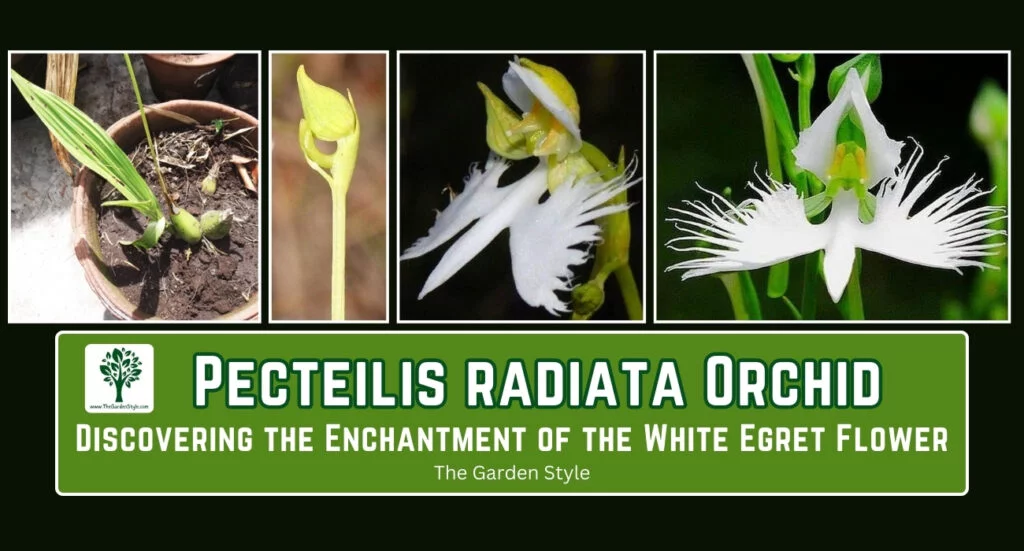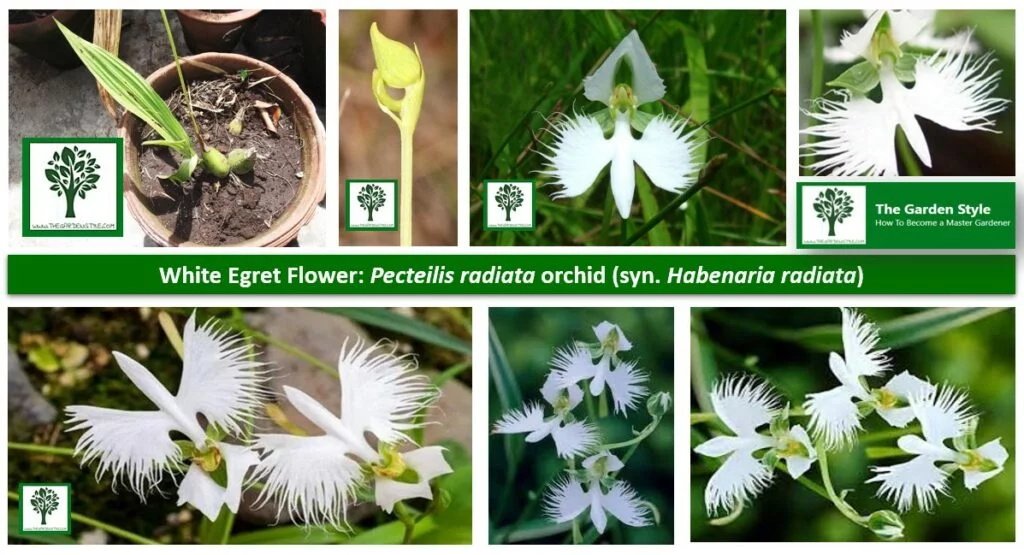The White Egret Flower, a beautiful orchid also known as Pecteilis radiata orchid (formerly Habenaria radiata), is a captivating orchid species renowned for its delicate beauty and ethereal presence. In this comprehensive guide, we delve into the enchanting world of the White Egret orchid, exploring its origins, cultivation techniques, and tips for care. Join us on a journey to uncover the secrets of this mesmerizing botanical wonder.
Table of Contents
Understanding the White Egret Flower: A Closer Look at Pecteilis radiata

Pecteilis radiata Orchid: Origins and Natural Habitat
The Pecteilis radiata orchid is native to various regions across Asia, including China, Japan, Korea, and parts of Russia. It thrives in diverse habitats such as grasslands, meadows, and woodland edges, where it adds a touch of elegance to the natural landscape.
Characteristics and Appearance
Characterized by its graceful form and pristine white flowers, the White Egret orchid is a sight to behold. With slender flower spikes reaching heights of up to 50 cm, each spike produces 2-3 exquisite blooms that bloom in late summer, creating a captivating display.
Creating the Perfect Environment for Cultivation
Lighting and Temperature Requirements
Provide bright, indirect light for the White Egret Flower, mimicking its natural habitat where it receives dappled sunlight. Maintain moderate temperatures between 18-24°C (65-75°F) during the day and slightly cooler at night to promote healthy growth.
Humidity and Air Circulation
To mimic the orchid’s native environment, ensure high humidity levels of around 50-70%. Use a humidifier or humidity tray to maintain optimal moisture levels and ensure good air circulation around the plant to prevent fungal diseases.
Essential Growing Tips for the Pecteilis radiata Orchid:
Watering and Potting Medium
Water the Pecteilis radiata orchid thoroughly when the top inch of the potting medium feels dry, allowing excess water to drain away. Use a well-draining potting mix suitable for orchids, such as a blend of bark, perlite, and sphagnum moss. Don’t use garden soil or potting soil mix. The key to successfully growing orchids from seeds is using soil dedicated to orchids.
Fertilization and Feeding
Feed the Pecteilis radiata Orchid with a balanced orchid fertilizer diluted per instructions every 2-4 weeks during the growing season, and reduce or cease fertilization during the dormant period in winter.

Seasonal Care: Dormancy, Propagation, and Pest Management
Dormancy and Winter Care
Allow the Pecteilis radiata orchid to undergo a dormant period during the winter months by reducing watering and ceasing fertilization. Keep the plant in a cooler location with reduced light to promote healthy growth.
Propagation and Repotting
Propagate the orchid through division, separating new growths or pseudobulbs from the parent plant during repotting. Repot the orchid every 1-2 years to ensure optimal growth and blooming.
Pest Management and Disease Prevention
Monitor the orchid regularly for signs of pests such as aphids, mealybugs, or spider mites, and treat infestations promptly with appropriate insecticides or horticultural oils. Ensure good air circulation to prevent fungal diseases.
Summary: Growing and Caring Tips for the Pecteilis radiata Orchid
Growing the White Egret Flower, or Pecteilis radiata, can be a rewarding experience, although it requires attention to specific care requirements to thrive. Just keep in mind these tips.
| Aspect | Tips |
|---|---|
| Lighting | Provide bright, indirect light |
| Temperature | Maintain moderate temperatures (18-24°C) |
| Humidity | Maintain high humidity levels (50-70%) |
| Watering | Water when the top inch of the potting medium feels dry |
| Potting Medium | Feed with balanced orchid fertilizer during the growing season |
| Fertilization | Water when top inch of the potting medium feels dry |
| Dormancy | Allow for a dormant period in winter |
| Propagation | Propagate through division and repotting |
| Pest Management | Monitor for pests and treat infestations promptly |
Remember to feed the White Egret orchid with a balanced orchid fertilizer prepared following manufacturer guidance every 2-4 weeks during the growing season (spring to early autumn). It’s key to keep blooming healthy. Reduce or cease fertilization during the dormant period in winter.
Sourcing White Egret Flower Seeds: Where to Find and How to Obtain
While finding Pecteilis radiata orchid seeds may require some effort, there are several sources where enthusiasts can obtain them. Online orchid nurseries, botanical gardens, and seed exchanges are great places to start your search for White Egret Flower seeds, Habenaria radiata seeds (it’s a synonym), or Pecteilis radiata seeds.
I found these seeds online, but I’m still in the process of growing them. I always like to recommend something that I have already tried, and that was successful. So far, it’s too early to celebrate. At least, germination was good. However, you know you can find seeds or seedlings when attending orchid shows and exhibitions. So, keep that in mind, too.
- Step 1 Combine 4 parts peat moss, 3 parts sphagnum moss, 1 part perlite and 1 part mycorrhizal fungi granules to create a well-draining, soilless growing medium that will encourage the seeds to germinate successfully. Add the soilless growing medium to a 4-inch planting container; choose a container with at least two 1/4-inch holes in the bottom to ensure healthy drainage.
- Step 2 Hold the planting container under room-temperature running water until you see it streaming from the drainage holes. Leave the container in the sink for five to 10 minutes to allow any excess water to drain from the growing medium.
- Step 3 Mix the seeds with 1/2 cup of fine horticulture sand; pour the mixture into an shaker with holes large enough to admit the small seeds. Sprinkle the sand and seed mixture evenly over the surface of the moistened growing medium.
Additionally, joining local orchid societies or clubs can provide opportunities to connect with fellow enthusiasts who may be able to share seeds or offer advice on cultivation.
When sourcing seeds or plants, ensure that you are obtaining them from reputable sources to support sustainable cultivation practices and avoid contributing to illegal or unethical harvesting of wild populations. Additionally, be prepared for the challenges of growing orchids from seed, as it can be a more involved and time-consuming process compared to starting with established plants.
Other phenomenal orchids exist, such as the Holy Spirit Orchid, also known as the Dove Orchid (Peristeria elata).
Frequently Asked Questions about White Egret Flower
Yes, it is indeed possible to find the White Egret Flower in its natural habitat. This orchid species is native to various regions in Asia, including China, Japan, Korea, and parts of Russia. In these areas, the White Egret orchid can be found growing in grasslands, meadows, and woodland edges.
However, due to factors such as habitat loss, overcollection, and environmental degradation, populations of this orchid may be declining in some regions. In response to these threats, conservation efforts have been initiated to protect this species and its habitat.
While finding it in the wild may require some effort and knowledge of its specific habitat preferences, encountering this elegant orchid in its natural environment can be a truly rewarding experience for nature enthusiasts and orchid lovers alike. If you plan to seek out this orchid in the wild, it’s important to respect local regulations and conservation guidelines to help preserve these delicate ecosystems.
Q: A: Yes, Habenaria radiata can be grown indoors with the right conditions, including bright, indirect light and high humidity levels.
Water your White Egret Flower when the top inch of the potting medium feels dry, ensuring thorough watering to prevent waterlogging.
While White Egret Flowers require specific care, they can be grown successfully with attention to their lighting, temperature, and humidity requirements.
It’s best to repot your White Egret orchid every 1-2 years, preferably after blooming, using a well-draining potting mix suitable for orchids.
Providing the right growing conditions, including adequate light, temperature, and humidity, along with proper fertilization, can help encourage blooming in Pecteilis radiata Orchids.
Embracing the Beauty of the Pecteilis radiata Orchid
In conclusion, Pecteilis radiata (White Egret orchid), with its graceful form and delicate blooms, is a true marvel of nature. By understanding its unique growing requirements and providing attentive care, enthusiasts can cultivate and enjoy the beauty of this enchanting orchid in their own homes and gardens. Let the White Egret Flower inspire awe and wonder as it adds a touch of elegance to your botanical collection.


